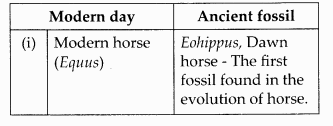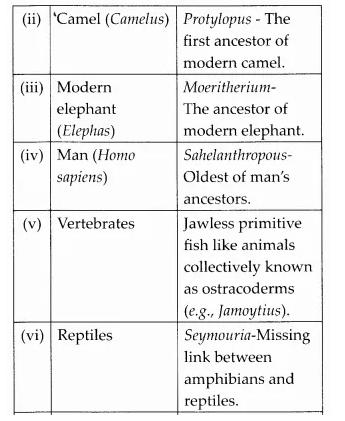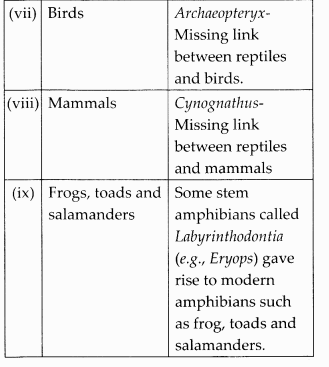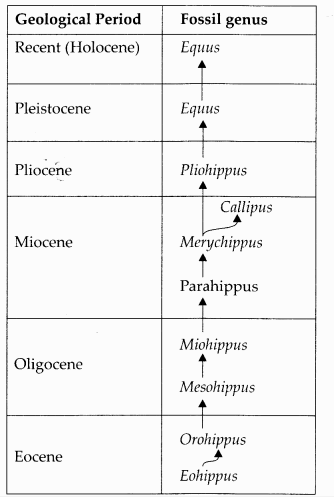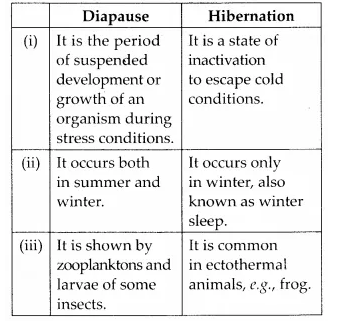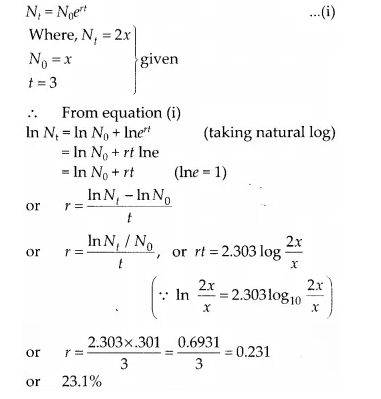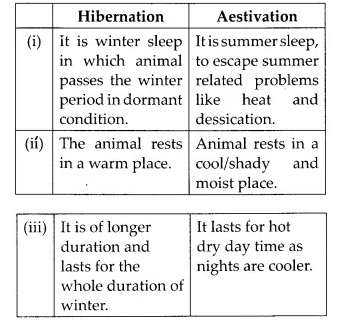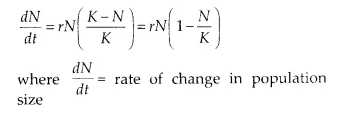NCERT Solutions for Class 12 Biology Chapter 2 Sexual Reproduction in Flowering Plants
These Solutions are part of NCERT Solutions for Class 12 Biology. Here we have given NCERT Solutions for Class 12 Biology Chapter 2 Sexual Reproduction in Flowering Plants
Question 1.
Name the parts of an angiosperm flower in which development of male and female gametophyte take place.
Solution:
Inside the anther, the cells of microsporangia develop as male gamete. Inside the ovary megasporangial cells develop as female gametes.
Question 2.
Differentiate between microsporogenesis and megasporogenesis. Which type of cell division occurs during these events? Name the structures formed at the end of these two events.
Solution:
Differences between microsporogenesis and megasporogenesis are as follows :
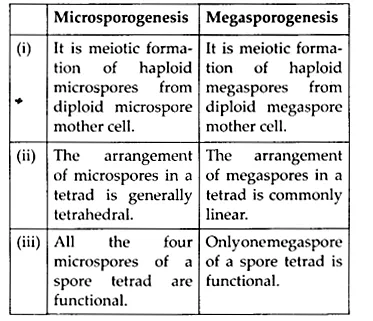
During microsporogenesis and Megas-megasporogenesis meiotic cell division occurs which results in haploid gametes – the microspores or pollen grains and megaspores.
Question 3.
Arrange the following terms in- the correct developmental sequence : Pollen grain, sporogenous tissue, microspore tetrad, pollen mother cell, male gametes.
Solution:
Sporogenous tissue → Pollen mother cell → microspore tetrad → pollen grain → male gamete.
Question 4.
With a neat, labelled diagram, describe the parts of a typical angiosperm ovule.
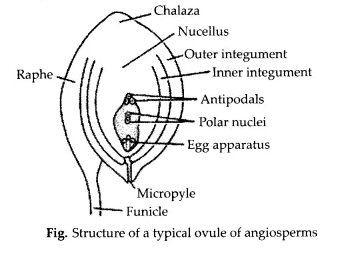
Solution:
An angiosperm ovule consists of the following parts:
- The ovule is attached to placenta by means of a stalk called funicle or funiculus.
- The point of attachment of funiculus to the body of ovule is called hilum.
- The main body of ovule is made of parenchymatous tissue called nucellus.
- Nucellus is covered on its outside by one or two coverings called integuments and hence ovule is rightly called as integument megasporangium.
- The integuments cover entire nucellus except for a small pore at upper end, which is called the micropyle. Micropyle is formed generally by inner integument or by both integuments.
- The place of junction of integuments and nucellus is called chalaza.
- In inverted ovules (most common type), the stalk or funiculus is attached to the main body of ovule for some distance to form a ridge like structure, called- raphe.
- In the nucellus of ovule, a large oval cell is present at micropylar end, which is known as embryo sac (female gametophyte), which develops from the megaspore.
Question 5.
What is meant by monosporic development of female gametophyte?
Solution:
The female gametophyte or the embryo sac develops, from a single functional megaspore. This is known as the monosporic development of the female gametophyte. In most flowering plants, a single megaspore mother cell present at the micropylar pole of the nucellus region of the ovule undergoes meiosis to produce four haploid megaspores. Later out of these 4 megaspores, only one functional megaspore develops into a female gametophyte, while the remaining 3 degenerates.
Question 6.
With a neat diagram explain the 7-celled, 8 nucleate nature of the female gametophyte
Solution:
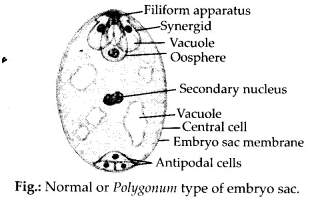
The female gametophyte (embryo sac) develops from a single functional megaspore. Thus, the megaspore undergoes three successive mitotic divisions to form 8 nucleate embryo sac. The first mitotic division in the megaspore forms 2 nuclei. One nucleus moves towards the micropylar end while the other nucleus moves towards the chalazal end. Then these nuclei divide at their respective ends and redivide to form 8 nucleate stages.
As a result there are 4 nuclei each at both the ends i.e., at the micropylar and the chalazal end in the embryo sac. At the micropylar end, out of 4 nuclei only 3 differentiate into 2 synergids and one egg cell. Together they are known as egg apparatus. Similarly, at the chalazal end 3 out of 4 nuclei differentiates as antipodal cells. The remaining 2 cells (of the micropylar and chalazal end) move towards the centre and are known as the polar nuclei, which are situated in the centre of the embryo sac. Hence, at maturity, the female gametophyte appears as a 7 celled structure, though it has 8 nucleate.
Question 7.
What are chasmogamous flowers? Can cross-pollination occur in cleistogamous flowers? Give reasons for your answer.
Solution:
Chasmogamous flowers or open flowers in which anther and stigma are exposed for pollination. Cross-pollination cannot occur in cleistogamous flowers. These flowers remain closed thus causing only self-pollination. In cleistogamous flowers, anthers dehisce inside the closed flowers. So the pollen grains come in contact with stigma. Thus there is no chance of cross¬pollination, e.g., Oxalis, Viola.
Question 8.
Mention two strategies evolved to prevent self pollination in flowers.
Solution:
Two strategies evolved to prevent self-pollination are:
- Pollen release and stigma receptivity are not synchronized.
- Anthers and stigma are placed at such positions that pollen doesn’t reach stigma.
Question 9.
What is self-incompatibility? Why does self-pollination not lead to seed formation in self-incompatible species?
Solution:
When the pollen grains of an anther do not germinate on the stigma of the same flower, then such a flower is called self-sterile or incompatible and such condition is known as self¬incompatibility or self-sterility.
The transference of pollen grains shed from the anther to the stigma of the pistil is called pollination. This transference initiate the process of seed formation. Self-pollination is the transfer of pollen grain shed from the anther to stigma of pistil in the same flower. But in some flower self¬pollination does not lead to the formation of seed formation because of the presence of same sterile gene on pistil and pollen grain.
Question 10.
What is bagging technique? How is it useful in a plant breeding programme?
Solution:
It is the covering of female plants with butter paper or polythene to avoid their contamination from foreign pollens during the breeding programme.
Question 11.
What is triple fusion? Where and how does it take place? Name the nuclei involved in triple fusion.
Solution:
Inside the embryo sac, one male gamete fuses with egg cells to form a zygote (2n) and this is called syngamy or true act of fertilisation. This result of syngamy, i.e., zygote (2n) ultimately develops into an embryo.
The second male gamete fuses with 2 polar nuclei or secondary nucleus to form triploid primary endosperm nucleus and this is called triple fusion. The result of triple fusion, i.e., primary endosperm nucleus (3n) ultimately develops into a nutritive tissue for developing embryo called endosperm.
The nuclei involved in this triple fusion are the two polar nuclei or secondary nucleus and the second male gamete.
Question 12.
Why do you think the zygote is dormant for sometime in a fertilised ovule?
Solution:
The zygote is dormant in fertilized ovule for some time because, at this time, endosperm needs to develop. As endosperm is the source of nutrition for the developing embryo, nature ensures the formation of enough endosperm tissue before starting the process of embryogenesis.
Question 13.
Differentiate between:
- Epicotyl and hypocotyl;
- Coleoptile and coleorhiza;
- Integument and testa;
- Perisperm and pericarp
Solution:
- Differences between epicotyl and hypocotyl are as follows :

- Differences between coleoptile and coleorhiza are as follows :

- Differences between integument and testa are as follows :

- Differences between perisperm and pericarp are as follows :

Question 14.
Why is apple called a false fruit? Which part (s) of the flower forms the fruit?
Solution:
Apple is called a false fruit because it develops from the thalamus instead of the ovary (the thalamus is the enlarged structure at the base of the flower).
Question 15.
What is meant by emasculation? When and why does a plant breeder employ this technique?
Solution:
Emasculation is the removal of stamens mainly the anthers from the flower buds before their dehiscence. This is mainly done to avoid self-pollination. Emasculation is one of the measures in the artificial hybridization. Plant breeders employed this technique to prevent the pollination within same flower or to pollinate stigmas with pollens of desired variety.
Question 16.
If one can induce parthenocarpy through the application of growth substances, which fruits would you select to induce parthenocarpy and why ?
Solution:
Oranges, lemons, litchis could be potential fruits for inducing the parthenocarpy because a seedless variety of these fruits would be much appreciated by the consumers.
Question 17.
Explain the role of tapetum in the formation of pollen-grain wall.
Solution:
Tapetum is the innermost layer of the microsporangium. The tapetal cells are multinucleated and polyploid. They nourish the developing pollen grains. These cells contain ubisch bodies that help in the ornamentation of the microspores or pollen grains walls. The outer layer of the pollen grain is called exine and is made up of the sporopollenin secreted by the ubisch bodies of the tapetal cells. This compound provides spiny appearance to the exine of the pollen grains.
Question 18.
What is apomixis and what is its importance ?
Solution:
Apomixis is the process of asexual production of seeds, without fertilization.
The plants that grow from these seeds are identical to the mother plant.
Uses:
- It is a cost-effective method for producing seeds.
- It has great use for plant breeding when specific traits of a plant have to be preserved.
We hope the NCERT Solutions for Class 12 Biology Chapter 2 Sexual Reproduction in Flowering Plants help you. If you have any query regarding NCERT Solutions for Class 12 Biology Chapter 2 Sexual Reproduction in Flowering Plants, drop a comment below and we will get back to you at the earliest.
